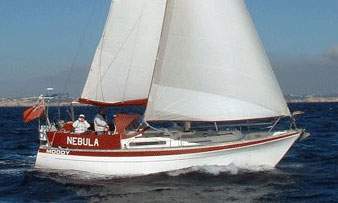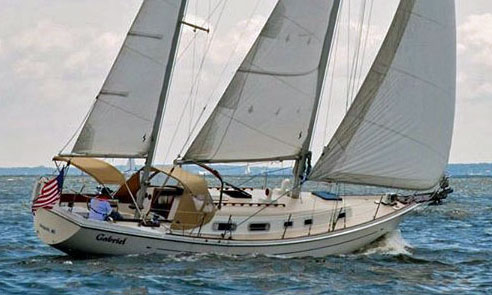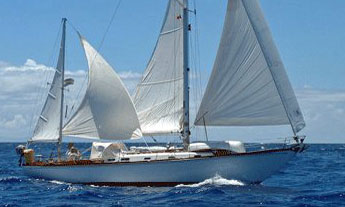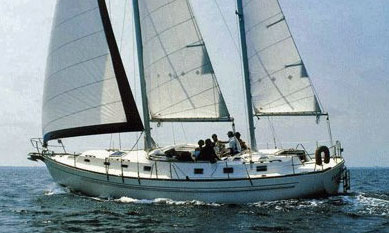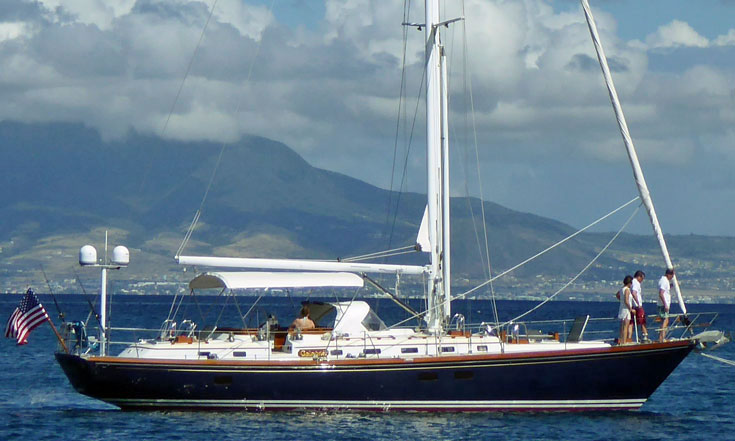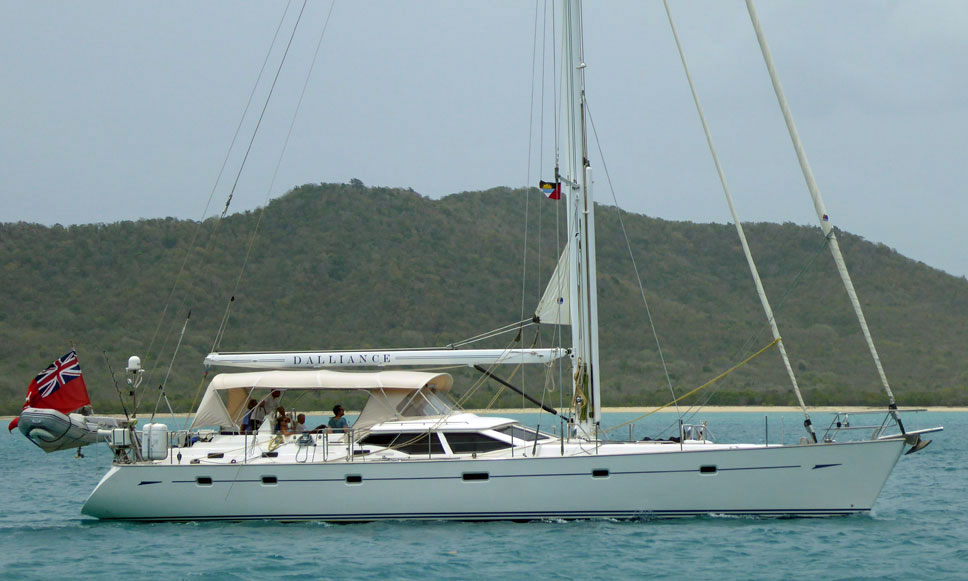- Home
- Cruising Yachts 45' to 50'
- Vagabond 47
The Vagabond 47 Sailboat
Specs & Key Performance Indicators
The Vagabond 47 is an ultra-heavy staysail ketch known for its robust build and bluewater capabilities. Designed by American naval architect William Garden, the boat combines substantial seafaring attributes with comfort and aesthetic appeal.
These sailboats were primarily built by Blue Water Yacht Builders in Taipei, Taiwan, during the late 1970s and 1980s, and was aimed at cruisers seeking a dependable and spacious vessel for long voyages.
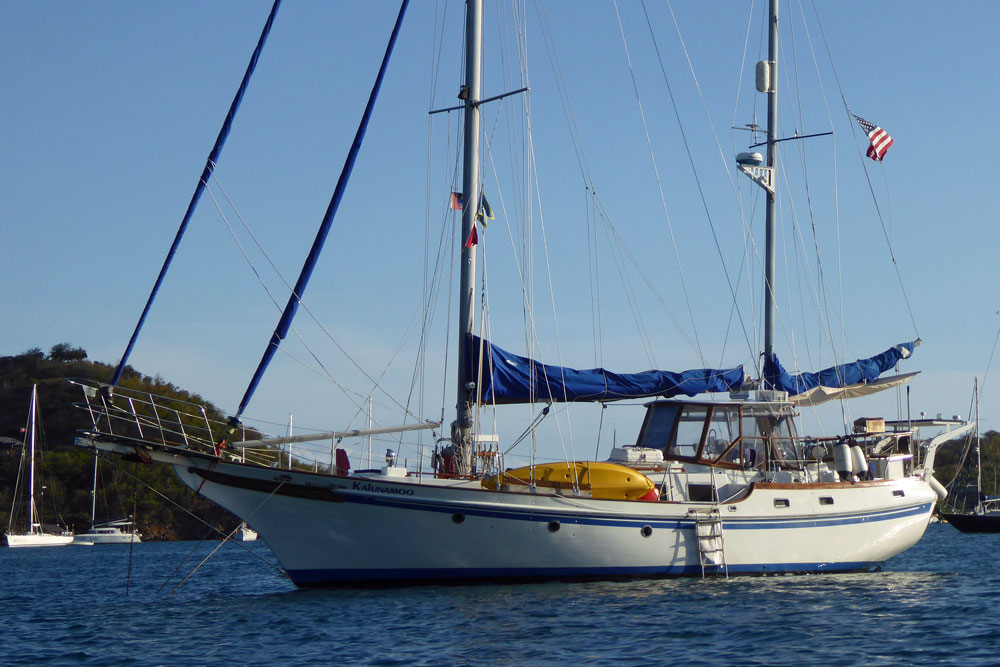 A Vagabond 47
A Vagabond 47Published Specification for the Vagabond 47
Keel & Rudder Configuration: Long keel, skeg-hung rudder
Hull Material: Fiberglass
Length Overall (LOA): 47'0" (14.3m)*
Waterline Length (LWL): 36'0" (10.98m)
Beam: 13'6" (4.16m)
Draft: 5'7" (1.71m)
Rig Type: Staysail Ketch
Displacement: 40,000 lbs (18,144 kg)
Ballast: 12,000 lbs (5,443 kg)
Water Tank Capacity: 230 gallons (870 liters)
Fuel Tank Capacity: 230 gallons (870 liters)
Hull Speed: Approximately 7 knots
Designer: William Garden**
Builder: Bluewater Yachts
Year First Built: 1979
Year Last Built: Early 1990s
Number Built: Approximately 200
* 55'0" to include bowsprit.
** William Garden, the designer of the Vagabond 47, also designed other models including the Vagabond 42, the Vagabond 52 and the Heritage West Indies 36.
The Vagabond 47 sailboat was also known as the Vagabond Voyager 47 and the Heritage Vagabond 47.
Sail Areas & Rig Dimensions
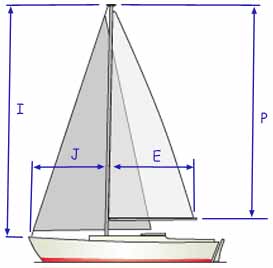 Sail Areas & Rig Dimensions
Sail Areas & Rig DimensionsI (Foretriangle Height): 9.14m (30'0")
J (Foretriangle Base): 7.32m (24'0")
P (Luff Length of Main Sail): 10.36m (34'0")
E (Foot Length of Main Sail): 5.49m (18'0")
Where:
- I is measured along the front of mast from the highest halyard to the main deck. The main deck is where the deck would be if there were no deckhouse.
- J is the base of the foretriangle measured along the deck from the headstay to the mast.
- P is the luff length of the main-sail, measured along the aft face of the mast from the top of the boom to the highest point that the mainsail can be hoisted.
- E is the foot length of the main-sail, measured along the boom from the after face of the mast to the outermost point on the boom to which the main can be pulled.
Published Design Ratios
The Key Performance Indicators (KPIs)
1. Sail Area/Displacement Ratio: 14.5
2. Ballast/Displacement Ratio: 27.5
3. Displacement/Length Ratio: 391
4. Comfort Ratio: 49.9
5. Capsize Screening Formula: 1.57
The following analysis of the primary design ratios gives an indication of the boat's likely sailing characteristics, but see the 'Notes of Caution' that follow below:
1. Sail Area/Displacement Ratio (14.5): This ratio suggests that the Vagabond 47 is somewhat underpowered, meaning it might not have the same performance capabilities as other boats in its class. It's designed more for comfort and stability rather than speed.
2. Ballast/Displacement Ratio (27.5): This ratio indicates a boat with moderate stiffness and power. It will have reasonable stability on the wind, but it won't be as stiff as boats with higher ratios. This makes it suitable for steady, comfortable cruising.
3. Displacement/Length Ratio (391): Falling into the ultraheavy displacement category, this ratio indicates the Vagabond 47 is a very heavy boat. Such boats generally offer a smoother ride, with less pitch and roll, but they require more sail area to achieve their design speed. They're built for comfort and heavy weather.
4. Comfort Ratio (49.9): This very high comfort ratio reflects a sedate motion, making the Vagabond 47 extremely comfortable for bluewater cruising. It suggests the boat will have a very stable and smooth ride, minimizing the rolling and pitching that can be unsettling during long passages.
5. Capsize Screening Formula (1.57): With a value below 2.0, the Vagabond 47 is well-suited for ocean passages, indicating it's less vulnerable to capsizing. This makes it a reliable choice for bluewater cruising, capable of handling challenging offshore conditions.
In summary, the Vagabond 47 is designed for comfort and stability rather than speed. It's an ideal vessel for long-distance, bluewater cruising, providing a smooth ride and reliable performance in various weather conditions.
Design Ratios: Notes of Caution...
- The Sail Area/Displacement Ratio (SA/D): This ratio provides an estimate of the sail power relative to the boat's weight, which can indicate potential speed in various wind conditions. But it doesn't account for the efficiency of the sail plan, the rigging, or the skill of the crew. Real-world performance can vary significantly based on these factors.
- The Ballast/Displacement Ratio (B/D): This ratio gives an idea of the boat's stability and stiffness, which is crucial for handling and safety. But it doesn't consider the distribution of the ballast or the hull shape, both of which can greatly affect stability. A high B/D ratio alone doesn't guarantee a stable boat if the ballast is poorly distributed.
- The Displacement/Length Ratio (D/L): This ratio helps predict the boat's speed potential and its behaviour in different sea conditions. But it doesn't account for the hull design or the boat's overall weight distribution. Two boats with the same D/L ratio can perform very differently if their hull shapes are different.
- The Comfort Ratio (CR): This ratio estimates the boat's motion comfort in a seaway, which is important for long passages. But it doesn't consider the boat's interior layout, which can also affect comfort. Additionally, personal tolerance to motion varies, so a boat that is comfortable for one person might not be for another.
- The Capsize Screening Formula (CSF): This formula assesses the likelihood of a boat capsizing in heavy seas, which is critical for offshore safety. But it doesn't take into account the boat's handling characteristics or the skill of the crew. A boat with a low CSF can still capsize if poorly handled in severe conditions.
General Limitations
- Static Nature: These ratios are static measurements and don't account for dynamic factors like wave action, wind gusts, or crew actions.
- Simplification: They simplify complex interactions into single numbers, which can be misleading. Real-world performance is influenced by a multitude of factors that these ratios can't fully capture.
- Context: The context in which the boat is used (e.g., coastal cruising vs. offshore racing) can greatly affect how these ratios should be interpreted.
In summary, while these ratios provide valuable insights into the theoretical performance characteristics of a sailboat, they should be used as part of a broader assessment that includes practical experience, sea trials, and expert advice.
More Specs & Key Performance Indicators for Popular Cruising Boats
This article was written with the assistance of Gemini, a large language model developed by Google. Gemini was used to gather information, summarize research findings, and provide suggestions for the content and structure of the article.
Recent Articles
-
The Ultimate Guide to Sailboats: Sloops, Ketches & More
Sep 11, 25 04:42 AM
A comprehensive guide to sailboat types. Learn the differences between monohulls and multihulls, sloops, cutters, ketches, yawls and schooners. -
Essential Sailing Knots & Splicing: The Ultimate Guide
Sep 11, 25 04:41 AM
Master essential sailing knots & splicing with our comprehensive guide. Learn their uses, history, and the anatomy of a perfect knot. -
The A-Z of Sailboat Rigging & Maintenance Explained
Sep 11, 25 04:31 AM
Decode sailboat rigging with our comprehensive guide. We cover everything from standing and running rigging to masts & spars, with expert insights for every sailor.
